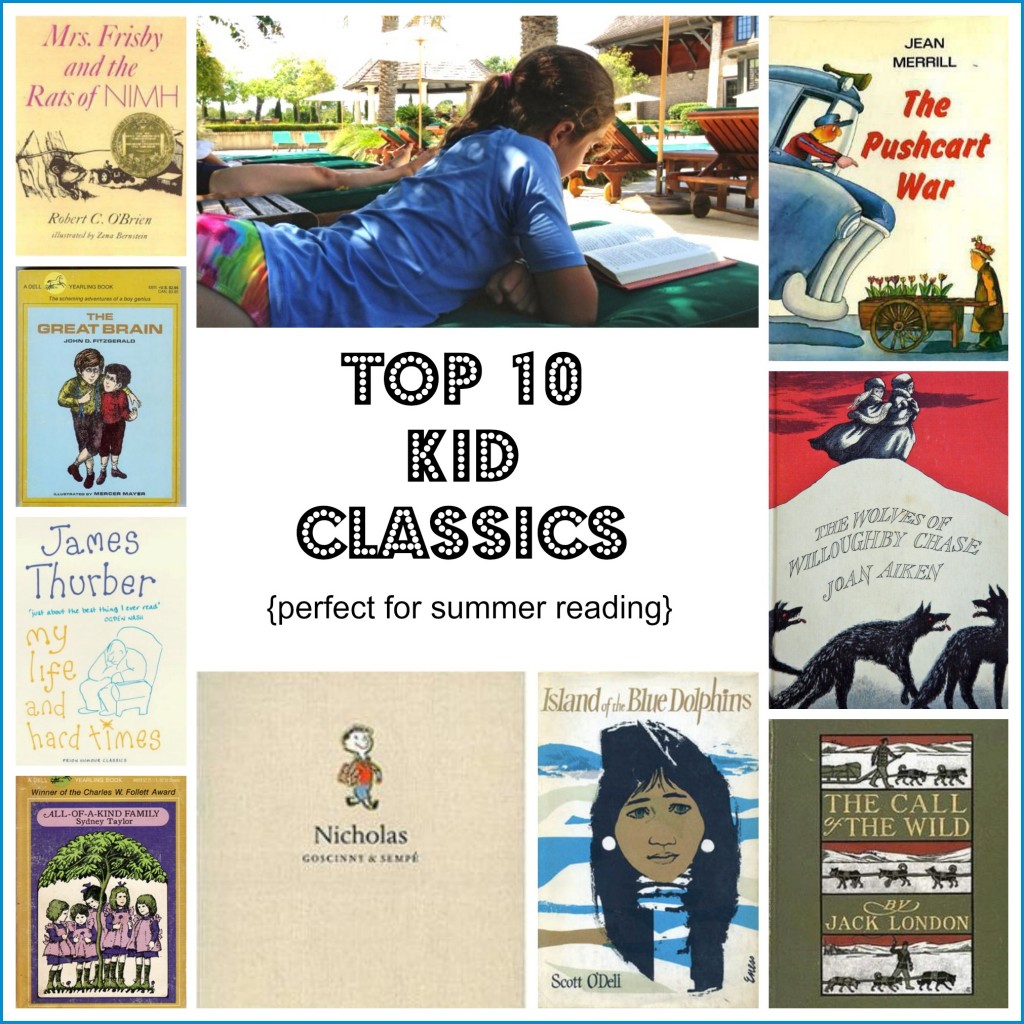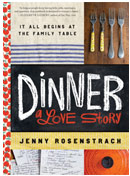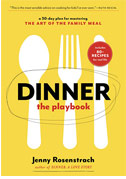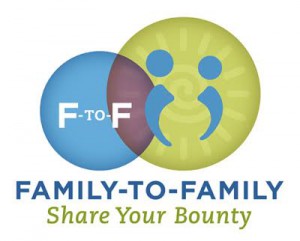Just in time for summer reading, I’m delighted to present this guest-post by Catherine Hong, veteran magazine editor and writer, mother of two, and the Mrs. behind Mrs. Little, one of my most favorite book blogs for kids that you should be reading if you’re not already. Take it away Catherine! –JR
I know that plenty of great children’s books were published after my 1970s childhood. I’ve heard a lot about these so-called new classics, like The Giver, Holes, The Hunger Games and Harry something-or-other. Once in a while I even allow my kids to read them. But there is truly nothing more gratifying than seeing your kids fall for one of your favorite books from your youth. Can anything match the warm, fuzzy feeling you get when you see your 10-year-old curled up with Harriet the Spy? (Bonus points if it’s your yellowed copy of Harriet with the original price of $1.50) It’s like a mother sheep recognizing her newborn by its smell — the feeling that says “this MUST be my child.” Sure, these old novels make references to telegrams and water closets, and fail almost every test of political correctness, but they’re so transporting they’ll keep your Clash of the Clans-obsessed offspring reading all summer.
ISLAND OF THE BLUE DOLPHINS (1960) By Scott O’Dell
When I re-read this recently it was as thrilling as I remembered it from fourth grade — but whoa! — much, much sadder. As you probably remember, the story is about a Native American girl, Karana, who finds herself alone on an island off the coast of California for many years after her people are forced to flee the island following a massacre. She has to figure out all the survival skills (hunting, spearmaking) that, as a female in the tribe, she was never taught. She battles hunger, weather, wild dogs, extreme loneliness and despair. O’Dell draws the landscape of the island so vividly you feel like you know every bluff and cove yourself.
What your kids will love: How Karana built a fence around her home using giant whale ribs tied with kelp to keep out the wild dogs.
What you only notice now: How crazy it is that Ramo (Karana’s little brother) is killed before they’ve been alone on the island a week. No kids’ book would let that happen today.
THE GREAT BRAIN (1967) By John D. Fitzgerald
My brother and I were crazy about this series, which is set in a Mormon town in Utah during the early 1900s. The main character is Tom, a precocious, money-loving 10-year-old who uses his “great brain” to swindle and con every kid in the neighborhood. Even when he does something heroic, like rescue two boys lost in a cave or help a crippled child to use his peg leg, he manages to come out with a silver dollar or two. (Some of the books in this series are now out of print — criminal!)
What your kids will love: How Tom masterminds his revenge on a schoolteacher by planting whiskey bottles in his bedroom and coat pocket.
What you only notice now: The boys were constantly whooping each other’s asses and the parents never once got involved. As the narrator, J.D. puts it, “It was just a question of us all learning how to fight good enough … After all, there is nothing as tolerant and understanding as a kid you can whip.”
Level: 4th & 5th graders
THE TWENTY-ONE BALLOONS (1947) By William Pène DuBois
Why has this incredible book not been made into a movie? It’s a fantasy-adventure about an explorer in the 1880s who stumbles onto the island of Krakatoa, where an ultra-civilized society of twenty families have invented their own calendar and government (a “restaurant government”) and live in unimaginable wealth, thanks to the island’s diamond mines. The book is wry, sophisticated and absurd, with fantastic illustrations (also by Du Bois).
What your kids will love: The fantastical Victorian-style inventions created by the Krakatoans, like the mechanical beds that rise up through the roof.
What you only notice now: It’s a children’s book that’s completely about adults. There are hardly any kids in the book, and the main character, a retired math teacher, confesses he doesn’t even particularly like children.
Level: 5th-6th grade
NICHOLAS (1960) By René Goscinny
Americans have Ramona Quimby, the French have Nicholas (or as he’s known there, “Le Petit Nicolas”), a spirited, perennially optimistic lad with a knack for getting into scrapes. Each chapter in the series — there are five volumes in English — reads as a self-contained story, usually focusing on an innocent escapade that goes totally awry. Each chapter generally ends in mild chaos or a slapstick-style melee; the tone is very Jacques Tati. A 5th grader could probably devour one of these books in an afternoon (it goes down like popcorn) but a 2nd or 3rd grader could also tackle these and be totally delighted.
What your kids will love: How Nicholas introduces the same friends in every story, as if we didn’t know them by now: Alec, “who is very fat and who eats all the time,” and Cuthbert, who “is top of the class and we’re not crazy about him, but we can’t hit him because he wears glasses.”
What you only notice now: The utter charm of the writing (even in translation), and how delicious those chocolate croissants that Alec is always eating must be.
MRS. FRISBY AND THE RATS OF NIMH (1971) by Robert C. O’Brien
As you surely remember, the story follows the plight of Mrs. Frisby, a widowed field mouse fighting to save her family from the farmer’s plow. When she asks for help from the mysterious rats living under the rosebush she discovers that they are a race of ultra-strong, ultra-intelligent escapees from a lab at the National Institute of Mental Health (NIMH). There’s almost a Harry Potter feeling to this book in the way O’Brien creates a fascinating and complex alternate world that secretly exists in parallel to our own.
What your kids will love: The description of the rats’ headquarters, outfitted with carpets, colored glass and tiny electric lights taken from Christmas trees.
What you only notice now: It’s the rare kids’ adventure story where the mother — not the child — is at the center. It’s Mrs. Frisby, a somewhat anxious widow and mother of four, who over the course of the novel realizes her potential for bravery and heroism.
Level: 3rd-4th grade
THE WOLVES OF WILLOUGHBY CHASE (1962) by Joan Aiken
More gothic than Lemony Snicket and page turnier than Dickens, this overlooked classic has it all: An English country manor house, a high-spirited rich girl, her penniless cousin, a tragic shipwreck, forged documents, a wicked governess, loyal servants, a grim orphanage and a pack of wolves “grown savage and reckless from hunger” who roam the countryside. It’s loaded with atmosphere, plot twists and melodrama.
What your kids will love: The Scooby-Do moment when the cousins discover a secret passageway behind the fireplace mantle by pushing the mounted deer head to one side.
What you only notice now: The hilarious names of the characters. The evil governess is Letitia Slighcarp, her menacing partner in crime is Mr. Grimshaw and yellow-eyed owner of the workhouse is Mrs. Brisket.
Level: 5th-6th
ALL-OF-A-KIND FAMILY (1951) By Sydney Taylor
Everything I know about Judaism I learned not from attending Bar Mitzvahs in Great Neck, or even marrying my husband (a nice Jewish boy), but from Taylor’s series about a family of five girls growing up on the Lower East Side at the turn of the century. It’s charming, it’s heart-warming, it’s what Laura Ingalls Wilder would have written if she grew up eating kreplech on Delancey Street.
What your kids will love: Learning what treats you could buy back then for just a penny: a bag of broken crackers, candied tangerines on a stick, a cone of roasted chick peas, a juicy sour pickle or some sort of candy called “chocolate babies” that are evidently extra fun to eat in bed.
What you only notice now: Their favorite part of Coney Island was the freak show. “To their delight, one of the freaks emerged from inside the tent to be gaped out at the audience. It was the Bearded Lady.” (Also on view: a midget and the “Wild Man from Borneo.”)
Level: 3rd-4th grade
THE PUSHCART WAR (1964) By Jean Merrill
A book of total genius that I pray will never go out of print. Written in the style of a historical report from the future, it recounts the events of a “war” on the streets of New York between corrupt trucking companies and a rag-tag band of pushcart peddlers. Led by Maxie Hammerman (a soft-spoken third-generation pushcart builder with a gift for strategy) the peddlers hatch a plan: they will flatten the truck tires using pea shooters so that everyone can see that the trucks are the cause of the traffic problems. Tony Kushner has said The Pushcart War is one of the most important books from his childhood (he spent two years trying to turn it into a film).
What your kids will love: Those pea shooters (duh!) made out of plastic yellow tubing, pins and dried peas.
What you only notice now: The lefty politics, sophisticated satire and postmodern flourishes.
Level: 5th/6th grade
Level: 6th/7th grade (seems to be required reading for a lot of 7th grades, and 7th was definitely the year I read it in middle school)








Ah, one of my favorite topics. I loved loved loved The Pushcart War! Definitely an all-time favorite. For some reason I could never get into Island of the Blue Dolphins as a kid. And I was introduced to Le Petit Nicolas as an exercise for learning French! 🙂
So, so true! The excitement I get from my daughter reading one of my favorite books pulled up from the basement is borderline ridiculous.
Great list. I can remember reading James Thurber too! Just ordered that and The Great Brain so my eldest son will hate me a little less for bringing him camping this summer to a wifi free zone.
Along similar lines, my favorite book from elementary school was Number the Stars by Lois Lowry. It’s a haunting story set during the Holocaust that sticks with me even today. Jenny, I hope your girls get a chance to read it!
I love the author’s description of All of Kind Family! I read every single one of these books as a kid, over and over again. And now, I often educate my (Jewish) fiance about the holidays, traditions, etc. that we experience with his family, based on my memories from this book.
I also plan to use the cleaning trick the Mom from this book used – she’d hide buttons and sometimes a coin or two around the room. The room was only considered clean if the daughter had found all of the buttons – and she got to keep the coins 🙂
Wolves of Willoughby Chase was one of my all time favorites! Such great characters and mischief! Also, My Side of the Mountain by Jean Craighead George (5th grade ish, but my 2nd grade teacher read it to us) was amazing. A boy moves to the mountains, befriends a hawk, carves out a home inside a tree… It totally captured my imagination. The Bridge to Terebethia was also amazing. My mom read it to me when I was little, changed the ending, then when I read it when I was old enough I was double-y sad!! But just beautiful. And, The Giver. I’m sure that will be big this summer with the movie coming out, but what a stunner.
Some of these I’ve read and LOVED, but quite a few I haven’t (huge for a lifelong book nerd). Now I have my own summer reading list!
This list is brilliant! I was reading and loving these books when I was a child too, and it was just so much fun to re-visit them here. I also loved sharing many of these titles with my boys and it was great fun to read, “What you only notice now,” because it was fascinating remembering what I had loved about these books, and why they still resonate. (Alas, I couldn’t get them interested in All-of-a-Kind Family, but LOVE your spot-on notion that Laura Ingalls Wilder would have written these books if she had grown up on the Lower East Side! What a hoot!) And thank you for the book covers! I can’t express the warm and fuzzy feeling of well-being that lavender and green cover of All-of-a-Kind Family still evokes! So wonderful to see it again!
so many good ones! also from the mixed up files of mrs. basil e. frankwiler was one of my faves:)
So many of my favorites here! I *love* The Great Brain books, my Mom has the whole set, and I am slowly finding (and shelling out big bucks) for the out-of-print books on eBay. And 21 Balloons has been a favorite of mine forever as well.
What an awesome list!
xox
Does Phoebe approve of this list? What would she add? Nerd Alert is the BEST!! And I’m a teeny tiny bit older (well, about 50 years older) but I totally love reading her blog! Yours, too, of course!!
Here’s another Joan Aiken book that I loved as much as Wolves of Willoughby Chase when I was in 4th grade: http://www.amazon.com/Midnight-Place-Joan-Aiken/dp/0618196250
Oh, Island of the Blue Dolphins!!! I just re-read this and I was so surprised at how much I had forgotten. It was still great.
Thank you for reminding of the title of “The 21 Balloons”.
I never read the French one, but it’s in good company (I loved all the Joan Aiken books. So creepy! So satisfying when the kids triumph!) so I’ll probably have to give it a shot.
And let me put in a plug here for E.L. Konigsburg, especially “From the Mixed-Up Files of Mrs. Basil E. Frankweiler” which I read so often I memorized it.
Thank you for reminding of the title of “The 21 Balloons”.
I never read the French one, but it’s in good company (I loved all the Joan Aiken books. So creepy! So satisfying when the kids triumph!) so I’ll probably have to give it a shot.
I too learned all about Judaism from “All of a Kind Family”! Very enlightening for a kid growing up in a series of very homogenous small towns.
And let me put in a plug here for E.L. Konigsburg, especially “From the Mixed-Up Files of Mrs. Basil E. Frankweiler” which I read so often I memorized it.
Great list! For Thurber I would add The Wonderful O and 13 Clocks. Also read and re-read: MY mother’s Oz books; all of E. Nesbit from the querulous and mischievous psammead series that starts with Five Children and It through The Wouldbegoods, The Bastables, the Railway Children and more. I loved Howard Pyle’s “boy” books: Men of Iron ( knights) and Robin Hood with their wonderful illustrations (Wyeth?) and of course Treasure Island, with ditto. Small things: The Borrowers series by Mary Norton –tiny people who live under the floor boards (Arietty had a wonderful cigar box canopy bed, needles needles for swords, spools for stools); Margery Sharp’s The Rescuers, mice who rescued prisoners lead by the doughty Miss Bianca; T.H. White’s Mistress Masham’s Repose, where Maria discovers an island inhabited by a colony of Lilliputians, and struggles with might versus right as King Arthur will in a grand scale in White’s masterpiece, The Once and Future King. All of Gerald Durrell, starting with My Family and Other Animals and following his true life adventures collecting animals for his zoo in the Isle of Jersey. I could go on for years, but enough. Oh, and Mary Poppins, please. And the various Andrew Lang fairy tale collections–violet, blue, red, etc. Thanks for letting me ramble down memory lane.
Oh, shoot, just one more: MY father’s Barnaby and Mr. O’Malley by the genius rocket Johnson, being reissued now in a large format. Collected comic strips about Barnaby, a young boy, and his cigar-smoking, hard drinking fairy godfather, Mr O’Malley, who faintly resembles Fiorella LaGuardia and is up to no good. The template for Calvin and Hobbes and every bit as wonderful and transgressive now as when it was written (40’s?).
Let’s not forget Tuck Everlasting by Natalie Babbitt!
The Pushcart War!! We live in Madison, WI, and this was a family read-aloud for us during the protests of 2011. The kids were a little young for it, but it helped us talk as a family about the influence of money in politics and the value of marching in the streets. It was one of my favorites when I was a kid; I remember reading it hunkered down in the school library stacks in fourth grade, thinking I was breaking some kind of rule with such a subversive book. Love, love, love.
In 5th grade, our teacher read us the entire “Great Brain” series. My favorite books from childhood!
And to this you have to add the original One Hundred and One Dalmatians by Dodie Smith. So much more intellectual than the Disney version, with a crisp, quintessentially British voice I adore. And the dogs – such wonderfully drawn characters.
I would also add Natalie Babbit’s Search for Delicious, which is part fantasy, part social commentary. It probably skews a little younger for straight plot, but the portrait of mob psychology is definitely something only older readers will comprehend.
The part about watching your child read the copies of books that you yourself read as a child gets me. I have saved many of the books I had as a little kid and i can’t wait for my little guy to read them.
Oh my gosh I loved all of the Great Brain books! We recently moved and in going through a couple of boxes of my old books I kept to pass along I came across the entire Great Brain set, which I plan to re-read. My girls are younger than all of these, so I will check out the other links you provide and some of your older posts, but thank you! Will file away for future reference!
I love it when my kids read my original copies. My two favorites that I saved and they have read are mixed up files and bunicula. They loved both but I think more since it was my copy. Then going around nyc on vacation made mixed up files even more meaningful. Love all your suggestions!
Oh if summer still meant reading books by the pool! Great list!
I know they are older, but don’t leave out Francis Hodgson Burnett’s The Secret Garden and A Little Princess. For a little girl they were magical.
Omg! For literally decades now, I have tried to remember the name of one of my favorite books from childhood, that book being All Of A Kind Family. I had tried googling “Book about Jewish girls, 1900s” and a million other terms with no success. I remember as a kid being fascinated by a look into a different time and culture and I even distinctly remember the part about the crackers lol. That book is solely responsible for starting in me a major love of history. Thank you soooooo much! All the books are now on my Amazon wish list in hopes I can afford them sooner or later. Thank you!